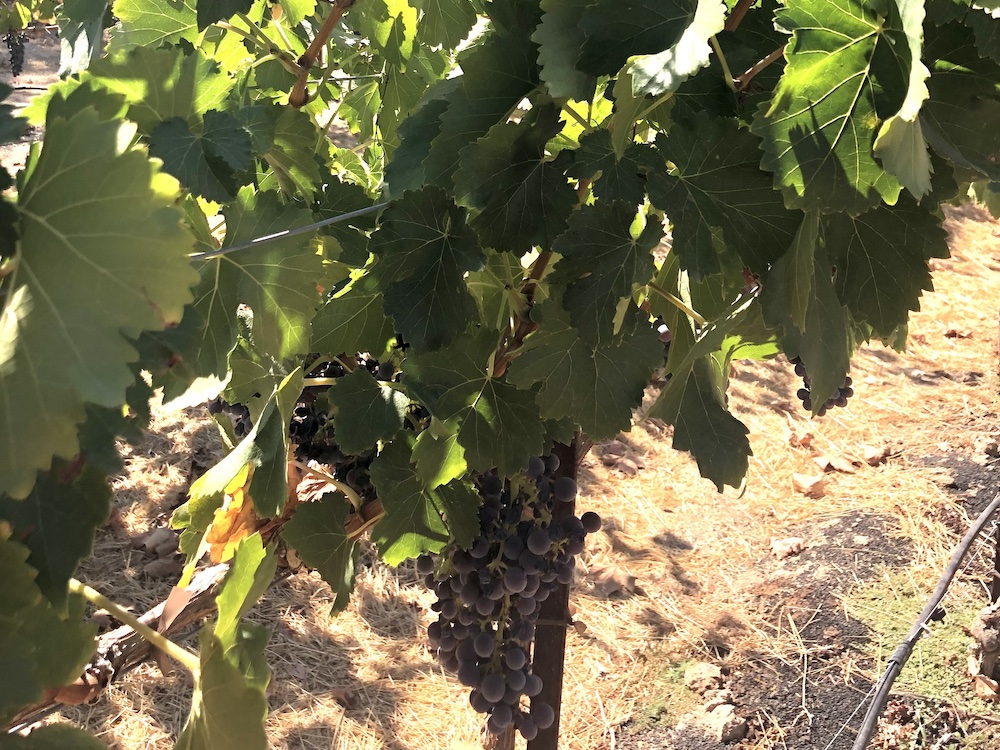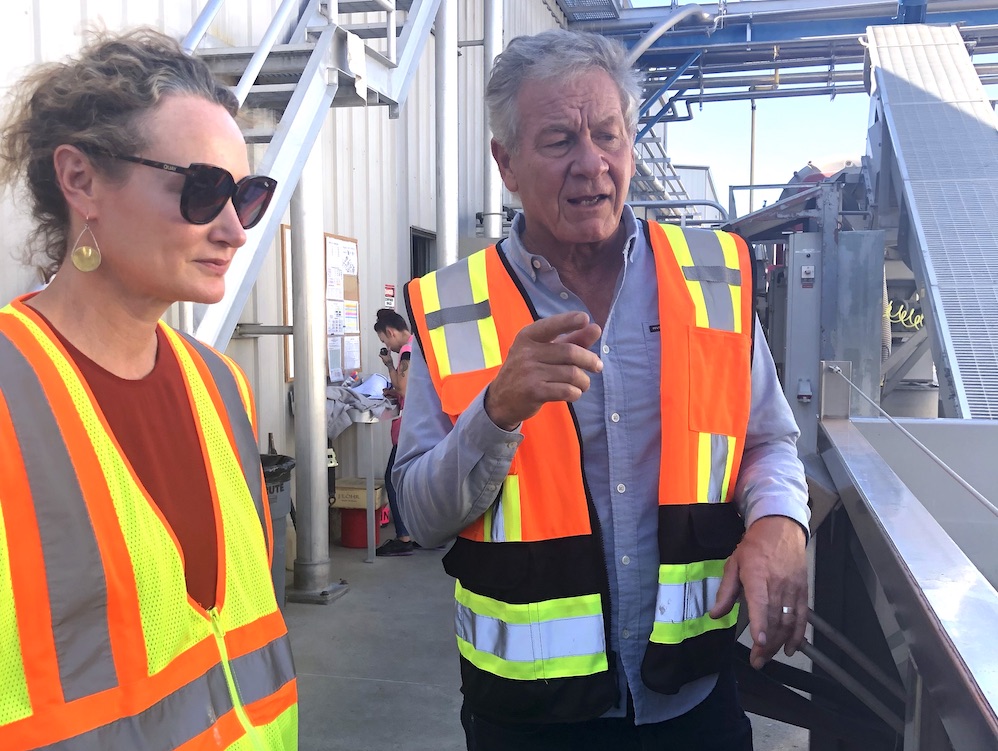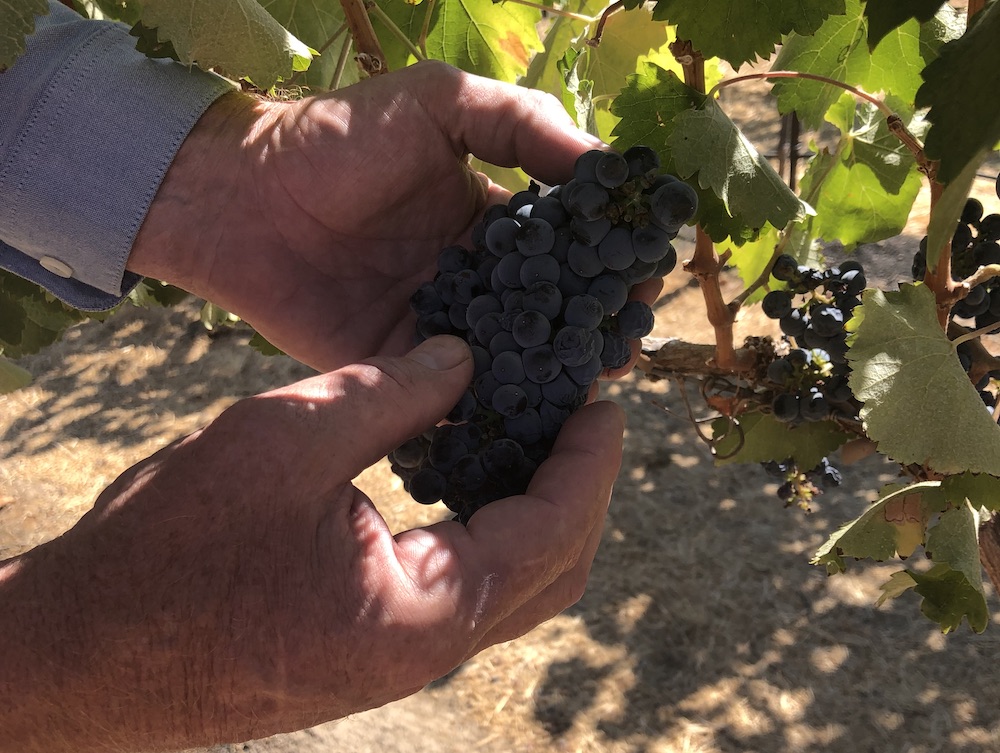
October 11, 2024 – There’s nothing like boots on the ground, or in my case running shoes, quickly donned to follow VP of Winemaking Steve Peck out into the vines that surround the J. Lohr tasting room and production facility on Airport Road in Paso Robles.
I’d never been before and was invited by VP of Marketing Rhonda Motil to check out the newly remodeled tasting room and go on a whirlwind production tour with Peck.
But first, on this brilliant Tuesday afternoon, we headed into the demonstration vineyard. This prime attraction borders the outside veranda of the tasting room, facing east, with an expansive view of the rolling vine covered hills just south of San Miguel.
A number of happy winetasters were parked in the shade, tasting J. Lohr wines that are made available for tasting room visitors and wine club members only. Among them, the 2023 Stairway Vineyard Grenache Rosé, which is as gorgeous to behold as any I’ve seen. And utterly delicious, with its abundant strawberry and raspberry aromatics and vivid strawberry, tangerine and passionfruit flavors. No simple watery sipper, it can hold up to the likes of strong cheddar and goat cheese without batting an eye.

“Notice how shiny the leaves are on the Grenache,” Peck pointed out, as the breeze flitted the sunlight across the gleaming canopy like an old-time shampoo commercial. How did those women ever get such shiny hair? Grenache sure has that type of voluminous, head turning canopy.
In contrast, Peck pointed to Mourvèdre. “Look at how dull and washed out the leaves are! But notice also how completely upright and tall the canopy is. This is typical Mourvèdre. It sets a big crop and puts up a ladder of leaves to support it, but about half way through the season, it starts to run out of gas and the leaves begin to senesce. It’s essential to drop crop at the right time.”
This is one of the vexing things about Mourvèdre, the other is that it struggles to ripen. When it does, it’s a magnificent combo of sweet teasing fruit and wildly animale character, bordering on animal sweat (a hard-ridden horse comes to mind) and grilled game. It’s generally excellent with boar sausage and lasagna with meat sauce, but its often feral nature is another reason why it ends up playing a minor role in the J. Lohr GSM blend.
“I wanted to make a 60% Syrah, 20% Grenache and 20% Mourvèdre,” says Peck. “But we ended up using generally less than 5% of Mourvèdre in our GSM blends. It’s like a cigar: there’s always someone who loves a cigar, but we felt its leather and game isolate it.”
Yet, they did make a varietal bottling of Mourvèdre for 2021, and that’s definitely worthy of exploring. I loved the opening salvo of raspberry and pomegranate, followed by stunning blue fruit and saddle leather. Think lamb, elk and venison.
At the end of the rows of usual Bordeaux varietal suspects, we stopped to sample Malbec, which Peck describes as Hawaiian punch, with sweet red fruit and notes of hibiscus. This fruit was super ripe, as the demo vineyard is not picked for production. Hence the Viognier and Grenache Blanc were golden raisin versions of themselves and utterly delicious. Maybe they can make a Late Harvest Field Blend out of the lot.
Most interesting to me, though, was the Saint-Macaire, which gets its name from the French village of Saint-Macaire, in the appellation of Côtes de Bordeaux Saint-Macaire. Peck told me that this was one of the originally sanctioned Bordeaux varietals, but it had fallen out of favor so much that there is scarcely an acre of it left planted there.

“Look at how tight the bunches are,” Peck said, grabbing a fistful. “It’s similar to Petite Sirah in both color pigmentation and cluster tightness, which makes it prone to bunch rot. You can see why it might not do so well in a climate where mid to late season rains, like they have in France, are common.”
In Paso it does really well, he says, and J. Lohr is among the only wineries to grow it. They planted it in the Buena Vista Vineyard in the Estrella District back in 2014 and produce single bottlings of it for the wine club. A bit of Saint Macaire is also added to the J. Lohr Signature Cabernet Sauvignon. I found the flavors surprisingly non-Bordeaux-ish, and more like Rhone, in the red and black plum, earthy chocolate and molasses cookie elements, but it still had decent acid. Intriguing. Gotta try the wine next time!
I could have listened to Peck tell personality stories about each grape varietal all day, as he’s got tons of grape gossip, with firsthand knowledge of all 2,700 acres of vines that J.Lohr farms in Paso Robles, along with 1,400 acres in Arroyo Seco. Plus there are 30 acres of Cabernet at Carol’s Vineyard in Napa. (Peck later showed me the numbers on the ongoing Cab ferments, including Carol’s: oh, yeah, that Napa Cab got really ripe in the heat.)
But we were late for a date with the crushpad and fruit was rolling in, so off we went to spy some gorgeous cold and destemmed Mourvèdre waiting for its next processing step. Delicious! Over on the other side of the facility, we were just in time to see a 1-ton bin of Cabernet Franc being hoisted over the special destemmer screw that Jerry Lohr had a hand in designing. It slowly rotates to avoid breaking up the berries. Peck pointed out that this fruit was machine-harvested and was pretty clean, with just a few stems present, as most of them have been left in the vineyard. What struck me was how plump and juicy the berries were.
Peck explained a few things about Cab Franc. “It’s a water sipper,” he said. “It only takes what it needs and retains it really well, whereas Syrah is a water hog. It will just drink and drink, no matter how much water you put on it.” Compared to Cabernet Sauvignon, Cab Franc is far more water efficient and those larger berries mean it remains nice and juicy during a heat spell.

Syrah was Peck’s pick as the grape horse that will win this year’s yield per acre race. He explained that this year looked to be about average when they began picking a month ago. They were expecting to bring in about 15,000 tons of Cabernet Sauvignon alone, which is their largest production varietal. But due to the intense and prolonged heat, Peck says that as the days and weeks have gone on, tonnage is dropping rapidly. Where they had hoped to get 4 to 5 tons per acre, they might be getting 2 to 3 tons. He was projecting a shortfall on Cab Sauv that would reduce their tonnage to between 10-11,000. That’s huge.
To make the visual point, he showed me the wall chart in the office of Brenden Wood, red winemaker at J. Lohr. It showed each tank in the facility with notes on what variety each contained and how much fruit went into it. There were a remarkable number of empty tanks for this late in the season.
Peck surmised this was happening in many parts of the largescale production wine ecosystem. It was good to get his perspective, since it echoes what some of our small boutique winemakers have reported: there is a shortfall in certain varieties like Cab. And yet, there are still vineyards that have not been picked and others left untended. It’s uneven.
As a result, Peck predicts that the saturated bulk market on the Central Coast at least, might be tapped to fill this shortfall. He’s actually optimistic that this imbalance situation will resolve naturally, due to supply and demand. After all, says Peck, Seven Oaks Cab helped build this winery and put Jerry Lohr’s kids through college.
Vineyards like Shotwell in the El Pomar District, Raincatcher and Stairway in the Adelaida District and all those in Arroyo Seco, will hopefully sustain the next generation of Lohrs, and the customers of today and tomorrow. Meanwhile, they provide ample reasons to visit a J. Lohr tasting room and sample some of the special wines that are not found in the broader market, like the excellent 2023 Raincatcher Viognier, 2022 Gesture GSM Rhone Blend, 2022 Stairway Mourvèdre, 2022 Home Ranch Cabernet Franc (Estrella District), and the top-level Bordeaux style blends, CuvéePau, Cuvée Pom and Cuvée St. E. (There’s a three-pack collection of 2021 Cuvées for $165: great gift idea.)
Club members get exclusive access to the rare Buena Vista Road Vineyard Saint-Macaire, but anyone can enjoy the fully fleshed out, carefully crafted wines that are synonymous with the J. Lohr brand, at pretty much any grocery store and wine shop, and many restaurants. Trust me, they pay attention to every single detail. You can’t find more consistent, dollar for dollar quality wines, across every single varietal than J. Lohr. There’s a reason they’re celebrating 50 years of winemaking excellence.
About the author
Laura Ness is a longtime wine journalist, columnist and judge who contributes regularly to Edible Monterey Bay, Spirited, WineOh.Tv, Los Gatos Magazine and Wine Industry Network, and a variety of consumer publications. Her passion is telling stories about the intriguing characters who inhabit the fascinating world of wine and food.
- Laura Nesshttps://www.ediblemontereybay.com/author/lness/
- Laura Nesshttps://www.ediblemontereybay.com/author/lness/
- Laura Nesshttps://www.ediblemontereybay.com/author/lness/
- Laura Nesshttps://www.ediblemontereybay.com/author/lness/


